AMERICAN FOOTBALL MONTHLY THE #1 RESOURCE FOR FOOTBALL COACHES
Article CategoriesAFM Magazine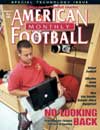
|
Packaging Your Passing Gameby: Patrick J Higgins© More from this issue As the passing game has evolved, problems have arisen in packaging the pass routes for all protections, personnel groups and formations. For example, we have 10 different personnel groups, ranging from three tight ends and two running backs, to five wide receivers. Making the passing game flexible enough to encompass all the variables can get difficult. Our offensive staff has put a great deal of time and thought into this, and has developed a comprehensive, yet very user-friendly, system for all parties involved (offensive line, tight ends, running backs and wide receivers). To come up with the system, we reviewed all the variables that must be considered. The variables are: How do I want to protect the quarterback (five-man, six-man, seven-man or maximum protection)? Do I want to throw hot? Do I have to adjust my route on certain coverages or blitzes? Does the read progression for the quarterback change according to coverages and blitzes? Does the personnel have to change with different routes? We packaged our routes with all these variables in mind while trying to make them simple to implement. We feel that we have designed a system that is both easy to implement and is fundamentally solid for addressing each variable. What we did is make our packages a three-two split or a four-one split. What we mean is that there will be three receivers strongside and two receivers weak, or four receivers frontside and one receiver weak. This allowed us to put a set of rules together for callside or frontside routes and weakside or backside routes. We gave each package a name such as, Choice, Scot, or AV/DV. We then designated the player doing the packaged route. Such as Y choice, Z scot and H AV. Once we know who is doing the packaged route, then all other personnel work off that route. 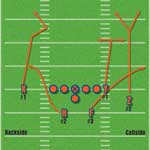
Diagram 1 For example, Diagram 1 shows a typical choice route by the tight end out of a two-back set. Frontside or callside, the Y (No. 1) runs a choice, the Z (No. 2) runs a takeoff or post and the back (No. 3) checks protection and runs a flat route. Backside, the receiver runs a post corner and the back checks protection and runs a flat route. (Note: The backside receiver's route may be changed by the quarterback at anytime. ) This is how this package is explained in our playbook: Concept: A package that isolates a receiver on a linebacker, with a post/takeoff and a flat route by the other frontside or callside receivers. The backside receiver/back will run a corner/flat combination if single and a smash in doubles or trips. This package can be run out of any formation or personnel group. This can be a horizontal and vertical stretch package. A five- or seven-step drop is taken by the QB. Responsibilities: Frontside/callside - No. 1 will run the Choice route. No. 2 becomes the receiver furthest out in the formation and he will run the post/takeoff. No. 3, the remaining receiver or back, will run the flat route. Backside - If single - Corner/Flat combination by the receiver (No. 1) and back (No. 2). If paired - smash route (two or three man side). F - on a four-man side will run a drag route across the ball at three yards. Progression: Pre-snap - Check post/takeoff or man cover backside, take either one if personnel, situation and coverage dictate. Post-snap - Y to Z to H, if in doubles, backside take smash when available. Now let's apply our rules. Frontside or Callside: The called or Choice route in this case becomes No. 1, the receiver furthest out is No. 2 and he runs a post/takeoff, the back then becomes No. 3 he has the flat route. Backside: The receiver furthest out, No.1, has the post/corner and the back, No. 2, has the flat. 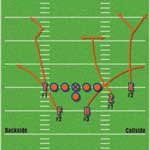
Diagram 2 
Diagram 3 Now let's apply this to a twins set (Diagram 2). The play here would be Z choice. Callside: Z is the called route, so he runs the choice. X (No. 2) is the furthest receiver outside, so he has the post/takeoff. The back is No. 3 and therefore has the flat route. Backside: Y, is No. 1 backside, runs a post/corner. The back is No. 2 and runs the flat. If we wanted to snug the X and Z and let X run the choice we could do that. The only difference would be that X and Z change responsibilities. (Diagram 3). We made one adjustment in this package but it stays consistent through the entire package. It refers to the backside if two or more players are on the LOS. Take the preceding formation and say we wanted to have Y run the choice. This would mean that we have a two man callside and a three man backside. Y (No. 1) would run the choice and the back would run the flat. Since there is no outside receiver the post/takeoff would not be run. So the rules are good for the frontside. The Backside now will run a smash route. X (No. 1) runs a hitch, Z (No. 2) runs a corner read and H (No. 3) runs a seam route. (Diagram 4) 
Diagram 4 This route structure allows for easy transfer from one package to another. Protection can either be seven- or six-man, depending on the situation or personnel match up. The progression for the QB is as follows: pre-snap post/takeoff - if coverage or personnel match up is favorable take it. Post snap: Choice, Flat or if coverage dictates work backside. The QB is told anytime the smash is available, throw the smash. The blitz adjustments are minimal in that the depth of the routes may be cut shorter, but the concept remains the same as does the progression for the QB. Now let's expand the package to incorporate the one-back sets. Again, if we follow the above set of rules, the transition should be easy and it should be equally easy to teach it. In Diagram 5, you see a pro trips formation. The play call is H choice. 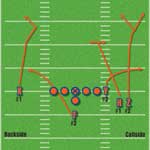
Diagram 5 Callside: H (No. 1) runs the choice, Z (No 2) runs the post/takeoff and Y(No. 3) runs the flat. Backside: X (No. 1) is single so he runs the post/corner and F (No. 2) runs the flat. If we wanted to run Y on the choice then H would become No. 3 and run a flat and Y is No. 1 and runs the choice. Nothing changes for the other receivers. If we motion Z and want Z to run the Choice, Z is No. 1 and runs the Choice, H is No. 2 and runs the post/takeoff and Y is No. 3 and runs the flat. The protection is five- or six-man and the read progression is the same for the QB. Let's look at a 2-by-2 set, as shown in Diagram 6. The play is H choice. Callside: H is No. 1 runs the choice, X is No. 2 and runs the post/takeoff and F is No. 3 runs the flat. Backside: since two or more players are on the LOS smash is run, Z (No. 1) runs a hitch and the Y(No. 2) runs a corner read. Protection and QB progression are the same. 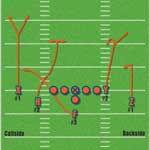
Diagram 6 In this trips closed formation (Diagrams 7, 8, 9) the choice can be run by any of the three players with the other two players responsible for the post/takeoff and the flat. If we want to choice the Y the three players backside now will run the smash. (Diagram 10) The protection and QB progression remain the same. 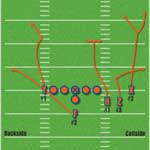
Diagram 7 
Diagram 8 
Diagram 9 
Diagram 10 
Diagram 11 Now let's empty the backfield. In Diagram 11 you will see a three-two split. If we want the choice run to the three-player side, those three players are responsible for the choice, post/takeoff and the flat. The backside two receivers/backs will run the smash. If the choice is run to the two player side, then they are responsible for the choice and post/takeoff and the backside three receivers/backs are responsible for the smash. (Diagram 12) If we chose to do a four-one split (Diagram 13). Then the difference is that No. 4 callside runs a drag route across the ball at three yards and X, since he is single, will run a post/corner. Protection is five-man and the QB progression is the same. 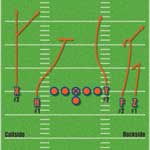
Diagram 12 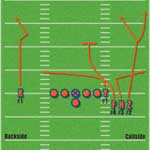
Diagram 13 It is to be hoped that you can see the applicability of this system. We can run what looks like many different routes, but it remains the same for the players and the QB. By doing this it allows us to repeat the route many times in practice and the QB gets adept at his progressions and the receivers become accomplished at running their routes. We feel that by teaching all the receivers, tight ends and running backs each route we create a lot of flexibility and this will allow us to take advantage of personnel mismatches and it also gives defenses a lot to prepare for in a short period of time. This system also grants the coach plenty of teaching time. The coach can really concentrate on the finer points of the routes and the package structure. We have five different packages that we can run out of any formation and personnel group. The choice package is just one of them. By using this packaging system we have seen our production increase to the point that our passing game has been ranked in the Top 25 the past two seasons and our QB had the sixth best passing efficiency in the country this past season. Drill A drill we like to do to help implement our packages is a version of the pat and go. We will line up five QB's and will callout a formation. Each QB is assigned a receiver. The cadence is called and the play is executed by all five QB's and all five players. Once the play is completed with no balls dropped, then we rotate QB's and rotate receivers. By rotating QB's and receivers you give each QB a chance to throw each route and each receiver a chance to run each route. We feel this helps the QB to understand each route and allows the QB to develop the proper sense of timing for each route. The drill also allows the receivers to learn each route and get a better understanding of the package and where the open windows are located. This is a great drill to get everybody on the same page, both players and coaches. It can be used in pre-practice or as part of your group work. We use it for both. |
|
| HOME |
MAGAZINE |
SUBSCRIBE | ONLINE COLUMNISTS | COACHING VIDEOS |
Copyright 2024, AmericanFootballMonthly.com
All Rights Reserved




